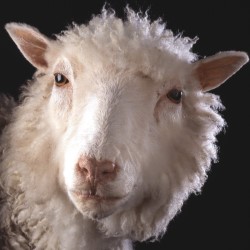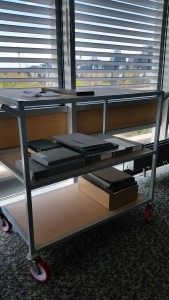It has been a while since my last post, but rest assured, the ‘Towards Dolly’ project has not been idle! As you’ll have seen from the last couple of posts, John Bryden has done a brilliant job digitising the Roslin glass slide collection. We’ve also been conducting some fascinating oral history recordings which we’ll post more about soon. But mainly, we’re excited to announce our forthcoming exhibition in the University of Edinburgh Main Library’s Exhibition Gallery. Titled ‘Towards Dolly: a century of animal genetics in Edinburgh’, this multimedia exhibition will explore the enormous contribution the Edinburgh area has made to the science of genetics over the last century. We will be open from 31 July to 31 October 2015 and also appear as part of this year’s Edinburgh Festival Fringe Festival: https://tickets.edfringe.com/whats-on/towards-dolly-a-century-of-animal-genetics-in-edinburgh
We’re thrilled to be featuring Dolly the sheep herself, on exclusive loan from National Museums Scotland, as well as an array of items from the archive and printed collections here at the library. The cloning of Dolly at the Roslin Institute in 1996 was an iconic event in science which captured the public’s attention in an unprecedented way, but it also forms part of a long narrative of extraordinary work by fascinating people in a variety of institutions.
As we’ve shown elsewhere on this blog, Edinburgh had a strong reputation in animal breeding research before the science of genetics formally came into being at the turn of the twentieth century. This was largely thanks to the work of James Cossar Ewart and his famous ‘Penycuik Experiments’. Ewart also helped establish a genetics lectureship at the University in 1911. By the 1920s and 1930s, the Institute of Animal Genetics was hailed as one of the most prestigious genetics research institutions in the world. We want the exhibition to give a flavour of some of the important studies being done in these early years, as well as the often active social environment.
As the 20th century progressed, genetics research branched out into different specialisms, and a variety of different institutions came into being. As knowledge and technology expanded, so did the potential for the science to make world-changing impact on human and animal health. The cloning of Dolly – and other sheep at the Roslin Institute including Megan and Morag – proved that even cells which had specialised (for instance, to become a heart or a liver cell) could be ‘reprogrammed’ to perform other functions, or become other types of cell. This knowledge had a big impact on existing research into stem cells, such as that being carried out at the University of Edinburgh’s MRC Centre for Regenerative Medicine. It has been a challenge – but an enjoyable one – to try and do justice to the pioneering discoveries, complex history and dynamic personalities and by selecting a relatively small amount of handpicked items. We hope that the exhibits we have chosen will stimulate discussion and debate, and leave our visitors wanting to find out more.
Keep your eyes peeled for more posts over the coming weeks as the exhibition starts to become a reality. Obviously we don’t want to spoil the surprise about what the other exhibits are going to be apart from Dolly, but here are most of them – packed away on a trolley!
Why not pop along to the Main Library before then though, and see our current exhibition, …Something Blue? https://exhibitions.ed.ac.uk/somethingblue
Clare Button, Project Archivist


